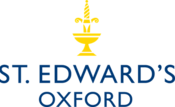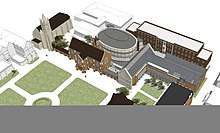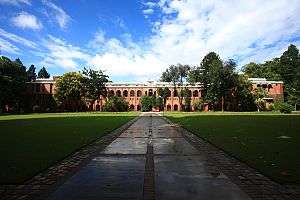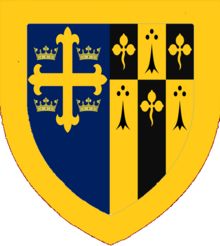St Edward's School, Oxford
St Edward's School (known colloquially as 'Teddies') is a co-educational, independent boarding school (an English public school) in Oxford, England.
| St. Edward's School, Oxford | |
|---|---|
 | |
| Address | |
Woodstock Road , , OX2 7NN England | |
| Information | |
| Type | Public school Independent day and boarding school |
| Motto | Pietas Parentum (Latin: "Parental Devotion") |
| Religious affiliation(s) | Church of England |
| Established | 1863 |
| Founder | Rev. Thomas Chamberlain |
| Department for Education URN | 123292 Tables |
| Chairman of Governors | Chris Jones |
| Warden | Stephen Jones |
| Staff | c.100 |
| Gender | Co-educational |
| Age | 13 to 18 |
| Enrolment | 696 Boys:420, Girls:276 |
| Houses | 13 |
| Colour(s) | Gold and Cornflower Blue |
| Publication | St Edward's Chronicle |
| Old Pupils Network | OSE Society |
| Telephone | 01865 319 204 |
| Boat Club | 1st VIII |
| Website | http://www.stedwardsoxford.org |
Approximately sixty pupils live in each of its thirteen Houses. The school is a member of the Rugby Group, the Headmasters' and Headmistresses' Conference, and the Oxfordshire Independent and State School Partnership. Termly fees in 2019/2020 are £13,160 for boarding and £10,530 for day pupils.[1] The school is also affiliated to the Church of England.
The School teaches the GCSE, A Level and International Baccalaureate (IB) qualifications. The Sixth Form is split evenly between pupils studying A Levels and the IB Diploma.
History

The School was founded in 1863 by the Rev. Thomas Chamberlain, student of Christ Church and vicar of St Thomas the Martyr. The original school building was Mackworth Hall, which then stood on New Inn Hall Street in central Oxford.
In 1873, after a storm damaged the school buildings and in anticipation of growing numbers, the Rev. A. B. Simeon, first Warden, moved the school to Summertown. At the time, the site was on the boundary of Oxford and surrounded by farmland, and Rev. Simeon bought a large plot for the school. The school remains on the 100-acre (0.40 km2) site today, with the Quadrangle and playing fields on opposite sides of Woodstock Road.
Simeon created an independent school with monastic-style buildings around a quadrangle.[2] St Edward's is the second largest quadrangle in Oxford, second only to Tom Quad at Christ Church. The original buildings were designed by William Wilkinson. The north range was built in 1873 and 1886, the gatehouse in 1879, and the east range, including Big School and the library, in 1881. Wilkinson's most significant building at St Edward's is the chapel, built in 1876.[3]
In the First World War more St Edward's pupils, pro rata, went to serve their country than from any other independent school in the UK. In Chapel the names of those former pupils who had lost their lives on the front line were announced. The walls of the chapel are lined with plaques remembering those former pupils who died in the Boer War, First World War, Second World War and subsequent wars.
The School flourished under the guidance of Warden Henry Ewing Kendall from 1925 to 1954.[4] In the 1930s, a subway was built underneath the Woodstock Road following the death of a pupil who was run over by a car. The subway was the first to be built in Oxford and is still used today.
In the Second World War air raid shelters were dug into the grass of the Quad. The School was presented with a stained glass window by the RAF at the end of the War in recognition of "the superb contribution to the war effort made by former pupils of the School". These included, among many others, Wing Commander Guy Gibson VC DSO&Bar DFC&Bar of 617 Squadron, who led 'The Dambusters', flying ace Group Captain Sir Douglas Bader CBE DSO&Bar DFC&Bar, and Adrian Warburton DSO&Bar DFC& Two Bars DFC(US), famous for his role in the defence of Malta.[5] Pacifist inclinations during the 1970s and 1980s caused the window to be relocated, before it was put back on display in the Old Library. The window has since been moved again and can now be seen on display in the Warden's Dining Room. The school also has a scholarship fund to assist pupils whose parents are in the armed forces.
In 1982, the School admitted its first girl, who joined in the Lower Sixth. The 11th Warden, David Christie, brought about an enormous change to the School when he fully developed the idea of allowing girls to join for the last two years of School (known as the Sixth Form). Following the success of a co-educational Sixth Form, the whole School became fully co-educational in 1997. In 1999, Holly Branson, daughter of Sir Richard Branson, became the school's first ever female Head Prefect and Head of School.
There is a large mural in the school's Dining Hall that depicts life at St Edward's. Included in the painting are a number of the characters from The Wind in the Willows, written by former pupil Kenneth Grahame.
Recent history
The School recently opened a new music centre. Opening to the pupils for the first time in January 2017, The Ogston Music School expands the musical repertoire of the School to new levels. The new facility features 20 practice rooms, seven ensemble rooms, the large Weston Recital Room, a rock room, the Fenton Recording Studio, and the Ferguson Sixth Form Music Library.

In 2016, the School announced a new building project to complete the School's main Quad, and in so doing complete the vision of St Edward's first Warden, the Rev. Algernon Simeon some 130 years after its first conception. Work for the new development began in the summer of 2018 and will provide the School with a new purpose-built Library, a spacious and flexible university-style Academic Centre, and a new Hall, with a capacity for 1,000 people. Designed by architect Nick Hardy (TSH Architects), the expected completion date of the first phase of this new development is during 2020. There are also plans in motion for a new boarding House, also with a view to completion in 2020.
July 2007 marked the official opening of The North Wall Arts Centre. The centre was built on the site of the old school swimming pool, which was the oldest swimming pool in the country.[6] The North Wall Arts Centre is run by Co-Artistic Directors Ria Parry and John Hoggarth, and is a producing theatre. The North Wall is central to the School, strengthening its links with the local community, which has been seen by many as vital given the current political debate on the charitable status of independent schools.[7]
The North Wall Arts Centre won several major architectural awards for its design,[7] including a RIBA award.[8]
The new Martyrs Pavilion, designed by architect John Pawson, was opened in 2009 and won the 2010 Oxford Preservation Trust award in the New Buildings category.[9]
Houses
There are 13 boarding houses which are home to approximately 50–60 boys or girls. Each House is run by Housemaster or Housemistress who is a member of the teaching staff at the School and lives in accommodation within the House with their family. Each House also has a set of House Tutors who supervise prep (homework) during the week and also tutor members of the House. Each House also has a dedicated matron who looks after pupils' medical (and often social) needs.
The school has around 120-day pupils, a small proportion of the total. Day pupils are expected to be in school from 8.30am Monday to Saturday. During the week, they may choose to depart at 6.30pm, or to stay in school until 9.00pm so that they have supper, complete supervised prep, take part in extra-curricular activities and enjoy leisure time with their friends. On Saturdays, day pupils leave after afternoon sport or other commitments. The School does not have day houses: all day pupils have a room within a boarding house and in most cases have their own bed and wardrobe. This policy means that the school does not have a day/boarder divide. Teachers often do not know who is a day pupil and who is not.
Sport
The sports on offer for girls include hockey, netball, tennis and rowing, while the main sports offered for the boys include rugby, hockey, cricket and rowing, with football also an proving increasingly popular option. The School has over 90 acres (360,000 m2) of playing fields in North Oxford.
The School has a regular fixture list against other UK public schools. Some of the fixtures on the fixture list have been played on the same weekend each year for decades. In boys' sports the schools main rivals include Radley College and Marlborough College and in girls sports, Marlborough, Stowe, and Oundle School.

In rowing the school has won The Princess Elizabeth Challenge Cup at Henley Royal Regatta on four occasions. The only British schools to have won the event more than this are Eton College and St Paul's School, London.[10] In 1984 the 1st VIII became the first ever crew to achieve the 'Triple', winning all three School events that year: The School's Head of the River; The Queen Mother Cup at the National Schools Regatta and The Princess Elizabeth Challenge Cup at Henley Royal Regatta. In 2013 the boys 1st VIII boat rowed in the fastest Princess Elizabeth Challenge Cup final ever seen at Henley, chasing the holders Abingdon School down to within half a length. Both crews beat the existing course record, having dispatched other leading international schools on the way to the final. In 2014, the boys 1st VIII were again the losing finalists, this time to Eton in another very close race. Having won Henley events seven times, (including three years as winners of the now discontinued Special Race for Schools) and been the losing finalist seven times,[11] St Edward's School is the third most successful boys' rowing school behind Eton College and Shrewsbury School. The school regularly provides rowers for Great Britain junior crews before going on to compete in the annual Oxbridge boat race or at Ivy League Universities.
St Edward's has seen several successful spells in hockey, which have included making the National Finals for both boys' and girls' hockey. The girls' hockey has been particularly strong and teams are frequently County Champions. In 2013/14 the school had both boys and girls in Regional, National and Great Britain squads. In 2010 the boys' hockey 1st XI won the inaugural Charlie Barker Trophy, a competition between local rival schools including Radley College, Eton College, Marlborough College, Abingdon School and Cheltenham College and finished the season unbeaten. Most recently, in 2018 the girls' U16 and U14 sides won their County tournaments with the 1st XI also progressing to the Regional tournament.
The 1st XV enjoyed a successful season in 2017, winning 10 matches and losing two, finishing 13th in The Daily Mail Trophy. 2017 was a good year for St Edward's further down the age-groups too, with the Junior Colts A (U15) and Junior Colts B XVs both recording seasons of 10 wins from 11 matches. In 2018, the 1st XV were crowned County Champions for Oxfordshire after beating Cokethorpe School in the final. There are some six former or present pupils in their respective age group's England development squads/teams including James Forrester. The school enjoys a strong reputation in Rugby Sevens participating in tournaments throughout the school's Spring Term. Smaller in number than many of their rivals, they frequently punch above their weight, aided by strong coaching throughout the school.
Cricket has been particularly strong in recent years and St Edward's has developed something of a reputation for success in the sport, culminating in the 2013 season, which was one of the most successful in the School's history for the 1st XI. It included victories over Radley College, Harrow, Uppingham School and Cheltenham College. In 2017, the 1st XI began the season with a historic win over Oxford MCCU in University Parks, going on to achieve 18 victories in the season - the second highest ever - the team was also crowned South Central T20 Champions. Former pupil AJ Woodland was announced as the Wisden School's Cricketer of the Year for 2016 and other accolades for current pupils included selection for England U17s, an England U19s Invitational XI, and a variety of representational and county sides. 2017 was the final season in charge for Master in Charge of Cricket Richard WJ Howitt, who broke the school's record for the number of victories as coach of the 1st XI in his final season, with a total of 170 wins between 2004 and 2017.
The School has many inter-house sporting events including the Steeplechase, and inter-house rowing, rugby, hockey, netball, squash, swimming and football, among others. The Steeplechase is the school's annual cross country race and is held once a year with the seniors running a 4-mile (6.4 km) race across Port Meadow the floodplain of the River Thames.
Alumni (OSE)
Former pupils of St Edward's are known as Old St Edward's, abbreviated to OSE. The Old St Edward's Society exists to maintain traditions and to promote the interests of the School, and to encourage mutual help between those who are and those who have been its members. It consists of past and present Wardens and members of the Masters' Common Room and all former pupils.
The society is run by a President and Secretary. Each year a new OSE President is elected. The OSE Society organise Special Gaudies for former pupils. Special Gaudies are held twice a year and are used as a means for former pupils to visit the school and see what has changed. The OSE Society also runs the very successful "OSE Undergraduate Evenings"; these evenings take place in notable university cities throughout the year, hosted by the Hon. Secretary.
All members of the society may wear the society tie, which is blue, with a gold cup and dagger on it. Former pupils are entitled to wear the Rhubarb Tie.
Notable OSE include:
- Gabriel Fielding ("Alan Barnsley") Distinguished Author W.H. Smith Literary Award Outstanding Contribution to English Literature 1963)
- Admiral Sir P Abbott GBE KCB, former Vice-Chief of the Defence Staff
- Group Captain Sir Douglas Bader, CBE, DSO & Bar, DFC & Bar WWII pilot
- Arthur Banks, WWII pilot awarded GC[12]
- Antony Barrington Brown, photographer and explorer
- Geoffrey Wallis Steuart Barrow DLitt FBA, FRSE, Honorary FSA Scot, British historian and academic
- Sir Russell Bencraft, cricketer
- Pippa Bennett-Warner, actress
- John Berger, art critic, novelist, painter, and author
- Richard Brooke, cricketer
- Nicholas Budgen, Conservative MP
- Admial Sir Harold Burrough GCB, KCB, DSO Assistant Chief of the Naval Staff in WWII
- Sir Geoffrey Callender, naval historian
- Richard Carline, artist
- Peter Carter-Ruck, lawyer
- David Frederick Case, audiobook narrator[13]
- Emilia Clarke, Four-time Emmy nominated actress
- Brian Cleeve, author and broadcaster
- Joshua Compston, gallerist
- Rear Admiral Anthony Cooke (Royal Navy officer), President of the Royal Naval College, Greenwich
- John Davies, businessman and cabinet minister
- Sir Geoffrey de Havilland, OM, CBE, AFC founder of de Havilland Aircraft Company.[12]
- Richard Dinan, businessperson[14]
- George Fenton, Oscar nominated film composer[12]
- Anthony FitzClarence, 7th Earl of Munster
- James Forrester, England rugby union international[15]
- Paul Gibb, England Test cricketer
- Wing Commander Guy Gibson VC, DSO and Bar, DFC and Bar, Dambusters hero,[12]
- Robert Gittings CBE, poet and biographer
- Jon Goodridge, rugby player
- John Galbraith Graham, crossword compiler (Araucaria)
- Kenneth Grahame, author[12]
- Ernest George Henham, author
- Mark Herdman, diplomat, Governor of the British Virgin Islands (1986–1991)[16]
- Sir Tom Hopkinson, journalist
- Noel Baring Hudson, DSO, MC Anglican Bishop
- Hugh Ingledew, Welsh rugby union international
- Stewart Innes, British Rower
- Poppy Jamie, TV Presenter
- Sir David Lewis, Lord Mayor of the City of London
- James Lockyer, Canadian lawyer and social activist
- Andrew MacLachlan, Scottish actor and cricketer
- Rob Marris, Labour MP
- Norman Miscampbell, Conservative MP
- Georgia Tennant, actress
- Sir John Moreton, KCMG, KCVO, MC, diplomat
- Simon Nicholls, BBC comedy producer
- Lord (Laurence) Olivier, actor, director and producer[12]
- Sir Derek Oulton, QC
- Hugh Padgham, record producer[17]
- Florence Pugh, Oscar nominated actress
- Sir Nicholas Pumfrey, judge
- Georgina Rylance, actress
- Lord (Michael) Sandberg, former CEO of HSBC Group
- John Sandoe bookseller[18]
- John Silver, early member of rock band Genesis
- Jon Snow, Channel 4 newscaster[12]
- Harmeet Singh Sooden, political activist
- Gordon Strachan, unorthodox minister
- Louis Strange, DSO OBE MC DFC WW1 pilot[12][19]
- Major-General Sir David Thorne, KBE CVO
- Sir Brian Tovey, former Director of GCHQ
- Sir Stephen Tumin, judge[12]
- Sam Waley-Cohen, Cheltenham Gold Cup winning jockey[12]
- William Wallace, Baron Wallace of Saltaire
- Adrian Warburton, DSO and Bar, DFC and Two Bars, highly decorated World War II British pilot[12]
- Vice Admiral Sir Barry Wilson (Royal Navy officer) KCB
- Sir Francis James Wylie, first Warden of Rhodes House
- Teddy Wynyard, DSO, OBE cricketer and footballer
Notable masters
Notable masters of the school include:
- James Cope, first-class cricketer (master in charge of cricket)
- The Right Reverend David Conner, KCVO, Dean of Windsor; former Bishop to the Forces (former school Chaplain)
- A. Maitland Emmet MBE, became one of Britain's foremost authorities on microlepidoptera[20]
- Sir George Mallaby, public servant (a former housemaster)
International links

The school has built up links with a number of schools around the world, which include:
- Mayo College, India.
- An exchange programme was set up in 1997 which saw a lower sixth boy study at Mayo and a lower sixth boy from Mayo study at Teddy's.
- The Gilman School Baltimore, USA.
- Gilman and St. Edward's operate a scholarship known as the Hardie Scholarship. One Lower Sixth boy from St. Edward's studies at Gilman during March/April and a Junior from Gilman studies at St. Edward's during June.
- Roland Park Country School, Baltimore, USA.
- In 2004 St. Edward's established an exchange programme with Roland Park. The programme runs at the same time as the Harry Hardie Scholarship, with one lower sixth girl from St. Edward's studying at Roland Park and a Junior girl from Roland Park studying at St. Edward's.
- The Doon School, India.
- An exchange programme was set up in 2002 which saw a lower sixth boy study at Doon School and a lower sixth boy from Doon study at Teddies.
- The King's School, Parramatta
- King's traditionally play Teddy's once every two years during their UK Rugby tour. Teddy's played King's in Sydney for the first time in 2003.
Arms
The school received a grant of arms in December 2017.[21]
 |
|
References
- "St Edward's Oxford, Oxford – Fees". stedwardsoxford.org. Retrieved 7 January 2019.
- Tyack, Geoffrey (1998). Oxford An Architectural Guide. Oxford & New York: Oxford University Press. p. 238. ISBN 0-19-817423-3.
- Sherwood, Jennifer; Pevsner, Nikolaus (1974). The Buildings of England: Oxfordshire. Harmondsworth: Penguin Books. p. 332. ISBN 0-14-071045-0.
- "Henry Ewing Kendall". National Portrait Gallery.
- Bowyer, Chaz Bomber Barons 1983 p.45 ISBN 0718303393
- https://www.stedwardsoxford.org/about-us/the-north-wall/
- Northwall website
- "RIBA National Awards 2008". Architecture.com. 23 June 2008. Archived from the original on 5 May 2012. Retrieved 12 May 2011.
- "News". Johnpawson.com. 18 January 2011. Retrieved 12 May 2011.
- "Results of Final Races – 1946–2003".
- "Results of Final Races – 1946–2003".
- "St Edward's Oxford – Notable OSE". Stedwardsoxford.co.uk. Retrieved 11 April 2012.
- Michael Taylor (8 October 2005). "David Case -- audio book voice". San Francisco Chronicle. Retrieved 30 December 2017.
- https://www.standard.co.uk/lifestyle/london-life/richard-dinan-the-posh-blond-his-harry-dating-cousin-and-why-made-in-chelsea-is-real-8306190.html
- Tozer, Malcolm, ed. (2012). Physical Education and Sport in Independent Schools. John Catt Educational Ltd. p. 291. ISBN 9781908095442.
- White, Laurence (28 August 2015). "John Mark Ambrose Herdman: Ulster diplomat served all over world in a distinguished career". Belfast Telegraph. Retrieved 3 September 2015.
- Holmes, Thom (2013). The Routledge Guide to Music Technology. Hoboken: Taylor and Francis. p. 223. ISBN 9781135477806. Retrieved 22 July 2014.
- "John Sandoe". Telegraph. 4 January 2008. Retrieved 11 July 2017.
- School website
- , The Guardian.
- https://www.college-of-arms.gov.uk/news-grants/newsletter/item/153-april-2018-newsletter-no-54
External links
- St Edward's School website
- Profile at the Good Schools Guide
- Profile at the Independent Schools Council website